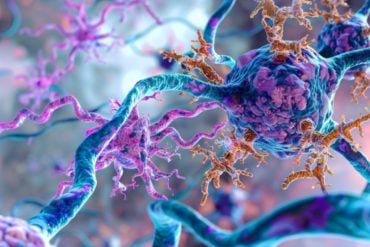Summary: Researchers conducted an analysis of genes in nearly 575,000 brain cells from individuals with and without post-traumatic stress and major depressive disorders (PTSD and MDD), yielding new insights into the brain’s stress response.
The study identifies varying gene expression levels in the dorsolateral prefrontal cortex (DLPFC) region among PTSD, MDD, and unaffected individuals. These findings could facilitate the development of novel biomarkers and treatment targets for these conditions.
Future research may involve studies with stem cell–derived cells to replicate and manipulate these findings, leading to potential therapies.
Key Facts:
- The study is a first-of-its-kind analysis involving approximately 575,000 individual brain cells from people with and without PTSD and MDD, exploring differential gene expression to understand the brain’s stress response.
- Specific gene expression changes in neurons and astrocytes within the DLPFC region of the brain could serve as potential biomarkers for PTSD and MDD, and also provide therapeutic targets.
- Future research plans include the use of stem cell–derived cells to further study these mechanisms and develop new therapies.
Source: McLean Hospital
An international team led by investigators at McLean Hospital has analyzed the genes expressed in approximately 575,000 individual cells from the brains of people with and without post-traumatic stress and major depressive disorders (PTSD and MDD), revealing new insights into the mechanisms behind the brain’s stress response in these conditions.
The findings, which are published in The American Journal of Psychiatry, could lead to novel markers of PTSD and MDD and well as new therapeutic targets.
Because studies have implicated the dorsolateral prefrontal cortex (DLPFC) region of the brain in PTSD and MDD, the scientists compared the genes expressed in cells in DLPFC samples collected postmortem from 11 individuals with PTSD, 10 with MDD, and 11 without either of these conditions with a replication dataset half the size.
The researchers detected which genes were expressed by which cells—including eight different types of cells—through a technique called single-cell RNA sequencing.
The analysis indicated that certain genes are expressed at varying levels in DLPFC neurons and astrocytes (a type of cell that supports neurons) depending on whether an individual had PTSD, MDD, or neither condition. For example, differential gene expression indicated increased glucocorticoid signaling in the brains of people with PTSD.
Various other pathways also had differential expression of genes across the study groups, suggesting that these pathways may be dysregulated in MDD or PTSD. Some of the genes that were identified were located in a region of chromosome 17 that has been implicated in neurodevelopmental and neurodegenerative disorders.
“Our findings can be used in the development of PTSD and MDD biomarkers to detect people at risk for the disorder since we linked the identified brain profiles with genetic risk. Excitingly, we have also associated our findings with brain imaging biomarkers that can be measured in patients to monitor disease status,” said senior author Nikolaos P. Daskalakis, MD, Ph.D., director of Neurogenomics and Translational Bioinformatics Laboratory at McLean Hospital.
“Our findings can also be used in the development of targeted treatments with cell type resolution. The observation of the neuronal glucocorticoid signaling pathway involvement means that neuron-specific glucocorticoid-based treatments could be developed compared with the current glucocorticoid treatments that affect most cell types, making them not specific and prone to side effects.”
Next steps that could bring this research closer to the clinic include studies involving stem cell–derived cells.
“Stem cell–derived cells exposed to stress agents could recapitulate brain stress pathology. Additional research could involve genetic and pharmacologic manipulations of these cells to study mechanisms and develop therapies,” said co-author Kerry J. Ressler, MD, Ph.D., chief scientific officer and chief of the Division of Depression and Anxiety Disorders at McLean Hospital.
“This study is very important because it provides a glimpse into how the brains of individuals struggling with PTSD and depression are similar and different at the cellular and molecular level in a critical region of the brain called the dorsolateral prefrontal cortex,” said Ned H. Kalin, MD, editor-in-chief, American Journal of Psychiatry.
“Using cutting-edge technology, the investigators established specific types of brain cells and specific genes within these cells that differ in their activity levels in relation to these stress-related and frequently co-occurring illnesses. The findings point the way to new cellular and drug targets that may benefit individuals with these disorders.”
About this genetics and mental health research news
Author: Nikolaos P. Daskalakis
Source: McLean Hospital
Contact: Nikolaos P. Daskalakis – McLean Hospital
Image: The image is credited to Neuroscience News
Original Research: Closed access.
“Single-Nucleus Transcriptome Profiling of Dorsolateral Prefrontal Cortex: Mechanistic Roles for Neuronal Gene Expression, Including the 17q21.31 Locus, in PTSD Stress Response” by Nikolaos P. Daskalakis et al. American Journal of Psychiatry
Abstract
Single-Nucleus Transcriptome Profiling of Dorsolateral Prefrontal Cortex: Mechanistic Roles for Neuronal Gene Expression, Including the 17q21.31 Locus, in PTSD Stress Response
Objective:
Multidisciplinary studies of posttraumatic stress disorder (PTSD) and major depressive disorder (MDD) implicate the dorsolateral prefrontal cortex (DLPFC) in disease risk and pathophysiology. Postmortem brain studies have relied on bulk-tissue RNA sequencing (RNA-seq), but single-cell RNA-seq is needed to dissect cell-type-specific mechanisms. The authors conducted the first single-nucleus RNA-seq postmortem brain study in PTSD to elucidate disease transcriptomic pathology with cell-type-specific resolution.
Method:
Profiling of 32 DLPFC samples from 11 individuals with PTSD, 10 with MDD, and 11 control subjects was conducted (∼415K nuclei; >13K cells per sample). A replication sample included 15 DLPFC samples (∼160K nuclei; >11K cells per sample).
Results:
Differential gene expression analyses identified significant single-nucleus RNA-seq differentially expressed genes (snDEGs) in excitatory (EX) and inhibitory (IN) neurons and astrocytes, but not in other cell types or bulk tissue. MDD samples had more false discovery rate–corrected significant snDEGs, and PTSD samples had a greater replication rate. In EX and IN neurons, biological pathways that were differentially enriched in PTSD compared with MDD included glucocorticoid signaling. Furthermore, glucocorticoid signaling in induced pluripotent stem cell (iPSC)–derived cortical neurons demonstrated greater relevance in PTSD and opposite direction of regulation compared with MDD, especially in EX neurons. Many snDEGs were from the 17q21.31 locus and are particularly interesting given causal roles in disease pathogenesis and DLPFC-based neuroimaging (PTSD: ARL17B, LINC02210-CRHR1, and LRRC37A2; MDD: LRRC37A and LRP4), while others were regulated by glucocorticoids in iPSC-derived neurons (PTSD: SLC16A6, TAF1C; MDD: CDH3).
Conclusions:
The study findings point to cell-type-specific mechanisms of brain stress response in PTSD and MDD, highlighting the importance of examining cell-type-specific gene expression and indicating promising novel biomarkers and therapeutic targets.







